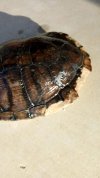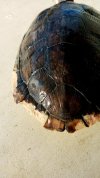- Joined
- Jul 8, 2017
- Messages
- 5,751
- Location (City and/or State)
- Low desert 50 mi SE of Palm Springs CA
I know absolutely nothing about turtles, so will go by what you "turt" folks think.
My friend has 2 RES, both over 7 years old, and both male. For the past 3 months or so, they have lived together in a stock tank...I don't know how many gallons it holds. I will guess that it's about 3' x 2' or a little bigger. All has seemed fine, with both eating and doing turtle things. They are able to get completely out of the water when desired.
My friend says one is an "Eastern" RES, and one is a "Western" RES.
The other day, when picked up, the "Eastern" turtle has these marks on him. We have wondered if this is some type of fungal shell rot, or a bacterial infection. Both turtles have been together, so the water doesn't seem to be an issue. The only thought we had was maybe the water gets too warm for the Eastern, since natively the water wouldn't reach the extreme heat that we have here in the low desert.
Then, upon closer inspection, I thought that possibly he is being chewed by the other turtle, but I don't know if this is an issue with turtles. The edge of the carapace looks gnawed, with pink areas in the center of the damage. It looks raw and is tender when touched. There is no injury to the plastron at all, and nothing above the edges on the carapace.
Here are pictures...what does everyone think, and how should we treat it? The turtles can be kept separately if necessary, but together would be ideal for their keeper. He was walking on gritty concrete, so you can see that on his plastron.



My friend has 2 RES, both over 7 years old, and both male. For the past 3 months or so, they have lived together in a stock tank...I don't know how many gallons it holds. I will guess that it's about 3' x 2' or a little bigger. All has seemed fine, with both eating and doing turtle things. They are able to get completely out of the water when desired.
My friend says one is an "Eastern" RES, and one is a "Western" RES.
The other day, when picked up, the "Eastern" turtle has these marks on him. We have wondered if this is some type of fungal shell rot, or a bacterial infection. Both turtles have been together, so the water doesn't seem to be an issue. The only thought we had was maybe the water gets too warm for the Eastern, since natively the water wouldn't reach the extreme heat that we have here in the low desert.
Then, upon closer inspection, I thought that possibly he is being chewed by the other turtle, but I don't know if this is an issue with turtles. The edge of the carapace looks gnawed, with pink areas in the center of the damage. It looks raw and is tender when touched. There is no injury to the plastron at all, and nothing above the edges on the carapace.
Here are pictures...what does everyone think, and how should we treat it? The turtles can be kept separately if necessary, but together would be ideal for their keeper. He was walking on gritty concrete, so you can see that on his plastron.


